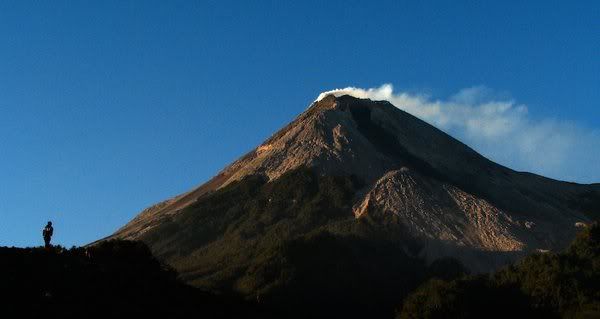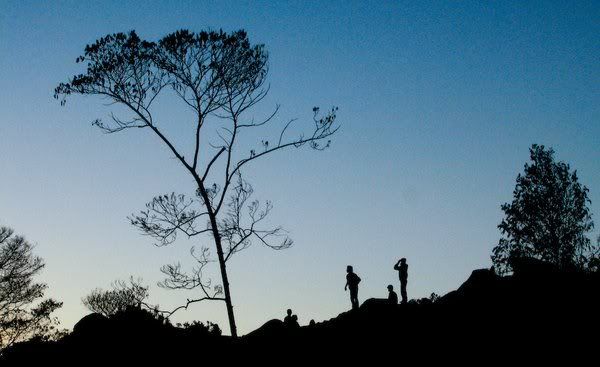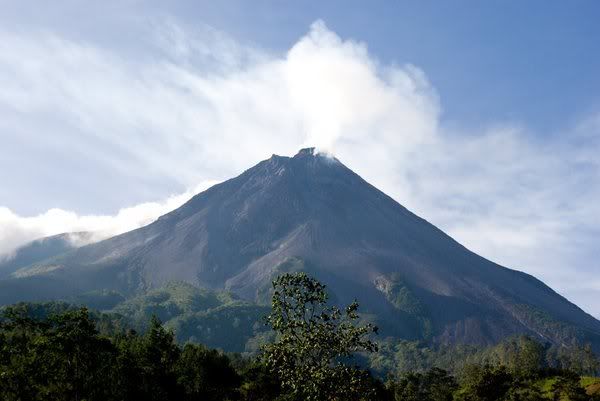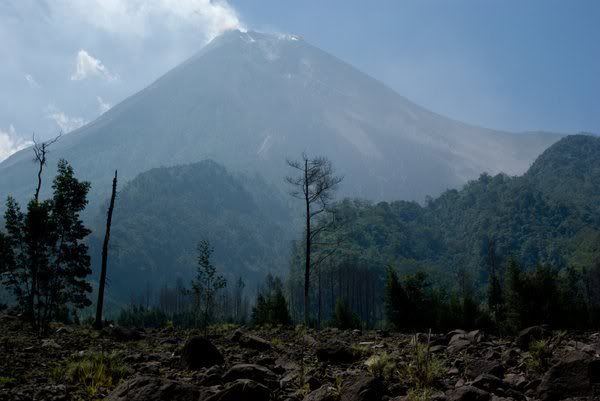Garebeg Keraton Ceremony
Garebeg Keraton Ceremony is a traditional ceremony which was held as a sovereign obligation to disseminate and protect the religion of Islam. The ceremony is better known by the name of this Grebeg first held by Sri Sultan Hamengkubuwono I (1755-1792).
The name itself comes from events Garebeg miyos or discharge from the sultan’s palace with family and relatives to give the mountain to its people. Discharge events sultan and his family are likened to the sound of wind blowing hard enough, causing the sound Garebeg … Garebeg … Garebeg …
Garebeg ceremony was held three times a year, on dates related to religious holidays of Islam, namely Garebeg Syawal, Garebeg Maulud, and Garebeg Large. Shawwal Garebeg implemented as a form of expression of gratitude from the palace after exceeding the fasting month, and at the same time to welcome the month of Shawwal. Garebeg Maulud held to celebrate and commemorate the birthday of Prophet Muhammad. While Garebeg Great, was held to celebrate Iduladha that occurred in the month of Dhul-Hijjah, which in Javanese calendar is often referred to as a big month.
Garebeg ceremony begins with a parade of soldiers palace. In the Palace of Yogyakarta, there are ten groups of soldiers, namely: Wirobrojo, Daheng, Patangpuluh, Jagakarya, Prawirotama, Ketanggung, Mantrijero Nyutra, Bugis, and Surakarsa. One by one, eight groups of soldiers out of Siti Hinggil through Pagelaran and stop at the North Square with his trademark line formation. Each group uses oversized clothes soldiers, carrying a special weapon, the banners, while playing an instrument. After eight groups of soldiers out, the line continued with the release of Mangala Yudha (commander of the palace). At the end of the parade, the mountain was taken out of Siti Hinggil with two groups of soldiers accompanied by the rest.
Mount is a pile of food that resembles the mountain, which is characteristic of every ceremony Garebeg. Mountains consist of a variety of crops, and is a symbol of prosperity Keraton, which will be distributed to the people. In celebration Garebeg, there are six types of mountains, each has a different shape and consists of different types of food. Dharat mountains are mountains that peak berhamparkan big cake shaped plates that are black and around-ilatan ditancapi with physical defect, namely the tongue-shaped sticky rice cake. Gepak mountains are mountains consisting of forty fruit basket containing a variety of small cakes with five different colors, namely red, blue, yellow, green, and black. Gunungan kutug / bromo made up of diverse pastries at the peak given hole, so that seemed a brazier containing burning embers of the incense. Lanang mountains at the peak ditancapi cake of rice flour called mustaka (head). These mountains consist of a series of long beans, red chilli, duck eggs, and sticky rice. Wadon mountains are mountains consisting of a wide range of small cakes and sticky rice cakes. Pawuhan mountains are mountains that looks similar to the mountains wadon, but at the peak ditancapi small white flag.
Mountains mountains are then taken to North Square. When it is, soldiers who had marched on the palace there give salvo (simultaneous firing a rifle), as a mark of respect. After a mark of respect is given, with accompaniment by all soldiers, mountain Gedhe Kauman brought to the mosque to pray by the lords of the mosque. After prayer, the mountains down to be taken by visitors who already look forward to his arrival in the vicinity of the mosque Gedhe Kauman. Once unloaded, an immediate scramble to take whatever food is prepared in the mountains. They are fighting over food is believed that the food there is in these mountains can bring blessings and prosperity. Some foods are believed to exist if planted in the fields or in the garden to enrich the soil, so the harvest will be good.
Overall Garebeg Ceremony held at three different places, but its location adjacent. The ceremony begins at the Exhibition Palace of Yogyakarta, then walked through the North Square, and ends at the Mosque Gedhe Kauman. Everything is located in the city of Yogyakarta, Yogyakarta Province, Indonesia.
To get to the palace, you can use the bus route Trans Jogja 1B, 2A, 2B, and 3A from the stop-stop nearby and pay Rp 3000.00 (2011). If using public transport, you should get off at the stop Post Office, then traveled by foot or use rickshaws to get to the palace. If you want more comfortable and easy, you can use a taxi from where you stay until the front of the palace window.
To enter the palace area and saw a whole series of this ceremony, guests are charged Rp 10.000,00 per person (2011).
Around the palace there are parking lots for motorcycles and cars, so for those of you who bring personal vehicles do not need to worry. In addition, outside the gates of the palace, visitors can find various kinds of sellers of traditional toys, souvenirs, and food and beverages.
The name itself comes from events Garebeg miyos or discharge from the sultan’s palace with family and relatives to give the mountain to its people. Discharge events sultan and his family are likened to the sound of wind blowing hard enough, causing the sound Garebeg … Garebeg … Garebeg …
Garebeg ceremony was held three times a year, on dates related to religious holidays of Islam, namely Garebeg Syawal, Garebeg Maulud, and Garebeg Large. Shawwal Garebeg implemented as a form of expression of gratitude from the palace after exceeding the fasting month, and at the same time to welcome the month of Shawwal. Garebeg Maulud held to celebrate and commemorate the birthday of Prophet Muhammad. While Garebeg Great, was held to celebrate Iduladha that occurred in the month of Dhul-Hijjah, which in Javanese calendar is often referred to as a big month.
Garebeg ceremony begins with a parade of soldiers palace. In the Palace of Yogyakarta, there are ten groups of soldiers, namely: Wirobrojo, Daheng, Patangpuluh, Jagakarya, Prawirotama, Ketanggung, Mantrijero Nyutra, Bugis, and Surakarsa. One by one, eight groups of soldiers out of Siti Hinggil through Pagelaran and stop at the North Square with his trademark line formation. Each group uses oversized clothes soldiers, carrying a special weapon, the banners, while playing an instrument. After eight groups of soldiers out, the line continued with the release of Mangala Yudha (commander of the palace). At the end of the parade, the mountain was taken out of Siti Hinggil with two groups of soldiers accompanied by the rest.
Mount is a pile of food that resembles the mountain, which is characteristic of every ceremony Garebeg. Mountains consist of a variety of crops, and is a symbol of prosperity Keraton, which will be distributed to the people. In celebration Garebeg, there are six types of mountains, each has a different shape and consists of different types of food. Dharat mountains are mountains that peak berhamparkan big cake shaped plates that are black and around-ilatan ditancapi with physical defect, namely the tongue-shaped sticky rice cake. Gepak mountains are mountains consisting of forty fruit basket containing a variety of small cakes with five different colors, namely red, blue, yellow, green, and black. Gunungan kutug / bromo made up of diverse pastries at the peak given hole, so that seemed a brazier containing burning embers of the incense. Lanang mountains at the peak ditancapi cake of rice flour called mustaka (head). These mountains consist of a series of long beans, red chilli, duck eggs, and sticky rice. Wadon mountains are mountains consisting of a wide range of small cakes and sticky rice cakes. Pawuhan mountains are mountains that looks similar to the mountains wadon, but at the peak ditancapi small white flag.
Mountains mountains are then taken to North Square. When it is, soldiers who had marched on the palace there give salvo (simultaneous firing a rifle), as a mark of respect. After a mark of respect is given, with accompaniment by all soldiers, mountain Gedhe Kauman brought to the mosque to pray by the lords of the mosque. After prayer, the mountains down to be taken by visitors who already look forward to his arrival in the vicinity of the mosque Gedhe Kauman. Once unloaded, an immediate scramble to take whatever food is prepared in the mountains. They are fighting over food is believed that the food there is in these mountains can bring blessings and prosperity. Some foods are believed to exist if planted in the fields or in the garden to enrich the soil, so the harvest will be good.
Overall Garebeg Ceremony held at three different places, but its location adjacent. The ceremony begins at the Exhibition Palace of Yogyakarta, then walked through the North Square, and ends at the Mosque Gedhe Kauman. Everything is located in the city of Yogyakarta, Yogyakarta Province, Indonesia.
To get to the palace, you can use the bus route Trans Jogja 1B, 2A, 2B, and 3A from the stop-stop nearby and pay Rp 3000.00 (2011). If using public transport, you should get off at the stop Post Office, then traveled by foot or use rickshaws to get to the palace. If you want more comfortable and easy, you can use a taxi from where you stay until the front of the palace window.
To enter the palace area and saw a whole series of this ceremony, guests are charged Rp 10.000,00 per person (2011).
Around the palace there are parking lots for motorcycles and cars, so for those of you who bring personal vehicles do not need to worry. In addition, outside the gates of the palace, visitors can find various kinds of sellers of traditional toys, souvenirs, and food and beverages.











 Read more: http://epg-studio.blogspot.com/2009/06/widget-pengatur-halaman-untuk-kembali.html#ixzz1UA3ocoWT
Read more: http://epg-studio.blogspot.com/2009/06/widget-pengatur-halaman-untuk-kembali.html#ixzz1UA3ocoWT